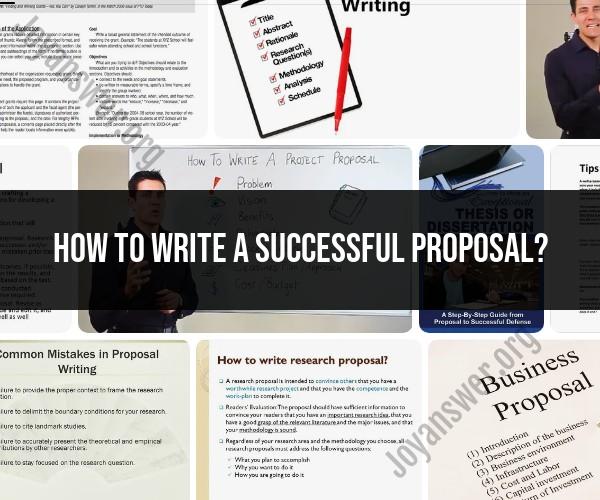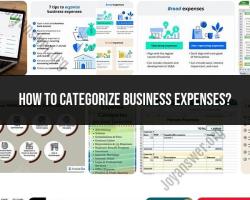How to write a successful proposal?
Writing a successful proposal requires careful planning, clear communication, and a persuasive presentation of your ideas. Whether you're writing a business proposal, a project proposal, a research proposal, or any other type of proposal, here's a step-by-step guide to help you craft a winning proposal:
1. Understand the Purpose and Requirements:
- Clarify the purpose of your proposal and what is expected of you. Understand the needs and expectations of the recipient or client.
2. Research and Gather Information:
- Collect all the necessary data and information relevant to your proposal. This may include market research, project details, budget information, and any other relevant facts.
3. Define Your Objectives:
- Clearly state the objectives you aim to achieve with the proposal. What problem are you addressing, and how will your proposal solve it?
4. Structure Your Proposal:
- Organize your proposal into sections, typically including an introduction, background, objectives, methodology, timeline, budget, and conclusion. The specific structure may vary depending on the type of proposal.
5. Write a Compelling Title and Introduction:
- Create a strong title that immediately grabs the reader's attention. Your introduction should provide an overview of what the proposal is about and why it's important.
6. Provide Background and Context:
- Offer a clear and concise background of the issue or project you are addressing. Explain why it is relevant and the current state of affairs.
7. Present Your Solution or Plan:
- Describe in detail how you intend to address the issue or achieve the objectives. Provide a step-by-step plan, including methods and strategies.
8. Support with Evidence and Data:
- Use data, statistics, case studies, and other forms of evidence to support your proposal. This lends credibility to your plan and helps justify your recommendations.
9. Address Potential Concerns and Objections:
- Anticipate and address any potential objections or concerns that the recipient may have. Show that you've thought through potential challenges.
10. Create a Realistic Timeline:
- If your proposal involves a project or a timeline, provide a detailed schedule outlining key milestones and deadlines.
11. Develop a Detailed Budget:
- If applicable, include a budget that clearly outlines the costs associated with your proposal. Be specific and transparent about expenses.
12. Highlight Benefits and Outcomes:
- Emphasize the positive outcomes and benefits that will result from your proposal. Explain how it aligns with the recipient's goals and needs.
13. Write a Persuasive Conclusion:
- Summarize the key points of your proposal and restate the benefits. Make a persuasive closing argument for your proposal.
14. Proofread and Edit:
- Carefully proofread your proposal to eliminate errors in grammar, spelling, and punctuation. Ensure it is well-organized and easy to read.
15. Seek Feedback:
- Before finalizing your proposal, get feedback from colleagues, mentors, or trusted individuals. They can provide valuable insights and suggest improvements.
16. Tailor to the Audience:
- Customize your proposal to the specific needs and preferences of the recipient. Make it clear how your proposal aligns with their goals and values.
17. Format Professionally:
- Present your proposal in a professional format. Use consistent fonts, headings, and formatting. Include any necessary attachments or appendices.
18. Follow Submission Instructions:
- Ensure you follow the submission guidelines provided by the recipient, including formatting, submission method, and any required documentation.
19. Submit On Time:
- Submit your proposal before the deadline. Late submissions may not be considered.
20. Follow Up:
- After submitting the proposal, follow up with the recipient to ensure they received it and to answer any questions they may have.
Writing a successful proposal takes time and effort, but by following these steps and customizing your approach to your specific proposal's needs, you can increase your chances of achieving a positive outcome.
Crafting a Successful Proposal: Essential Steps
A successful proposal is one that clearly and concisely communicates the value of your proposed solution to the potential client. It should be well-written, persuasive, and tailored to the specific needs of the client.
Here are some essential steps for crafting a successful proposal:
- Understand the client's needs. The first step is to thoroughly understand the client's needs and objectives. What are they trying to achieve? What challenges are they facing? Once you have a good understanding of the client's needs, you can tailor your proposal accordingly.
- Develop a strong solution. Once you understand the client's needs, you can develop a solution that meets those needs. Your solution should be innovative, feasible, and affordable. Be sure to clearly articulate the benefits of your solution and how it will help the client achieve their objectives.
- Write a persuasive proposal. Your proposal should be well-written, persuasive, and easy to read. Be sure to use clear and concise language, and avoid jargon. Be sure to also highlight your team's experience and expertise, and demonstrate why you are the best company to deliver the proposed solution.
- Proofread carefully. Before submitting your proposal, be sure to proofread it carefully for any errors in grammar or spelling. You may also want to have someone else proofread it for you.
Proposal Writing Excellence: Tips for Success
Here are some additional tips for writing excellent proposals:
- Be specific and quantify your results. When possible, use numbers and data to quantify the expected results of your proposed solution. This will help the client to see the value of your solution and how it will benefit them.
- Use strong visuals. Visuals can help to make your proposal more engaging and easier to understand. Consider using charts, graphs, and images to illustrate your points.
- Be realistic and honest. Don't overpromise or make claims that you can't deliver on. Be realistic about your proposed timeline and budget.
- Tailor your proposal to the client. Take the time to tailor your proposal to the specific needs and objectives of the client. This will show the client that you are serious about their business and that you have taken the time to understand their needs.
- Get feedback. Ask someone else to review your proposal before submitting it. This could be a colleague, manager, or mentor. Getting feedback can help you to identify any areas that need improvement.
Winning Proposals: Strategies for Success
Here are some strategies for writing winning proposals:
- Start early. Don't wait until the last minute to start writing your proposal. Give yourself plenty of time to gather information, develop your solution, and write a well-crafted proposal.
- Do your research. Learn as much as you can about the client, their industry, and their competitors. This will help you to tailor your proposal and demonstrate your expertise.
- Be creative. Don't be afraid to think outside the box and come up with creative solutions to the client's problems.
- Be persistent. Don't give up if you don't win the first proposal you submit. It may take multiple proposals to win a client's business.
By following these tips, you can increase your chances of writing winning proposals.












